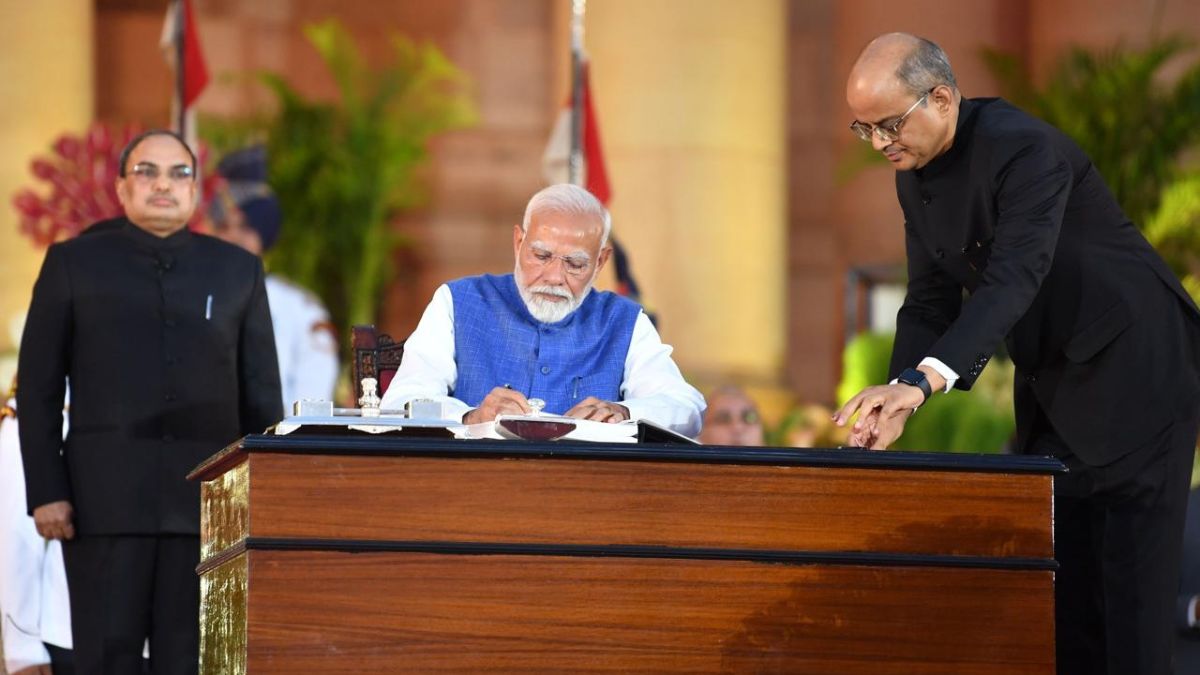Prime Minister Narendra Modi, in his third term, has chosen to retain several key portfolios while allocating other crucial ministries to prominent leaders within his government. The move is meant to highlight continuity and centralisation of power for significant policy matters.
The decision has also put a spotlight on Modi’s trust in a select group of ministers to handle pivotal roles while keeping a firm grip on critical sectors himself.
Which are the ministries retained by Modi?
Modi has retained several important ministries, including the Ministry of Personnel, Public Grievances and Pensions, the Department of Atomic Energy, and the Department of Space.
Additionally, any ministry not explicitly assigned to another minister remains under his purview. Currently all other ministries have been assigned to a Member of Parliament (MP).
This centralised approach allows Modi to directly oversee significant policy areas and maintain control over critical administrative functions.
Ministry of Personnel, Public Grievances and Pensions:
This ministry is pivotal for overseeing the bureaucracy and ensuring efficient public administration. A notable agenda item is the ongoing demand to ensure pensions under the National Pension System (NPS) are at least half of the last salary drawn.
Approximately 8.7 million central and state government employees, enrolled in the NPS since 2004, may benefit from potential reforms. A committee led by Finance Secretary TV Somanathan was formed in March 2023 to explore ways to enhance pension benefits within the NPS framework without reverting to the non-contributory Old Pension System (OPS).
Impact Shorts
More ShortsDepartment of Atomic Energy:
Modi’s retention of this department underscores its strategic importance. Established in 1954, the Department of Atomic Energy (DAE) is headquartered in Mumbai and was initially led by Jawaharlal Nehru with Homi Bhabha as its secretary.
The DAE is crucial for developing nuclear power technology and applying radiation technologies in agriculture, medicine, industry, and basic research. It comprises five research centers, three industrial organisations, five public sector undertakings, and supports eight institutes of international repute.
The DAE’s programmes aim to enhance nuclear power’s share in India’s energy mix and develop advanced technologies such as accelerators, lasers, and supercomputers.
Department of Space:
The Department of Space (DoS) manages India’s ambitious space programme, including the Indian Space Research Organisation (ISRO). Under Modi’s leadership, ISRO achieved significant milestones, including the successful landing of Chandrayaan-3 near the Moon’s South Pole and the launch of India’s maiden solar mission, Aditya L-1 .
The DoS aims to develop space technology for socio-economic benefits, managing satellite systems for communication, television broadcasting, meteorological services, and resource monitoring.
What is the role of Jitendra Singh?
Jitendra Singh, a three-time BJP MP from Jammu and Kashmir’s Udhampur constituency, continues to hold significant responsibilities as the Minister of State (independent charge) of Science and Technology and Earth Sciences.
He oversees the Ministry of Personnel, Public Grievances, and Pensions, along with Atomic Energy and Space, assisting Modi in these areas. Singh has been instrumental in advancing India’s space exploration efforts and implementing public administration reforms and pension-related policies.
Role of Modi and Cabinet committees
The prime minister forms Cabinet committees, assigning specific functions to them and ensuring their effective operation. These committees typically comprise three to eight members, predominantly Cabinet ministers. Modi himself often chairs these committees to steer significant policy decisions and resolve critical issues.
Also Read: How upcoming polls influenced Modi’s portfolio allocation for new Cabinet
Currently, there are eight Cabinet committees: the Appointments Committee of the Cabinet, Cabinet Committee on Economic Affairs, Cabinet Committee on Political Affairs, Cabinet Committee on Investment and Growth, Cabinet Committee on Security, Cabinet Committee on Parliamentary Affairs, Cabinet Committee on Employment & Skill Development, and Cabinet Committee on Accommodation.
These committees play a vital role in formulating proposals for the Cabinet and taking decisions on assigned matters.
A brief look at Modi’s strategic allocation
In his third term, Modi prioritised continuity by retaining key ministers in their previous roles. Amit Shah continues as Home Minister, S Jaishankar as External Affairs Minister, Nirmala Sitharaman as Finance Minister, and Rajnath Singh as Defence Minister.
Nitin Gadkari remains in charge of Roads, Transport, and Highways, while Sarbananda Sonowal oversees Shipping and Ashwini Vaishnaw retains Railways. These reappointments reflect Modi’s confidence in their capabilities and their crucial roles in his administration’s long-term plans.
Jyotiraditya Scindia was appointed to the Telecom Ministry, and Ram Mohan Naidu from the Telugu Desam Party (TDP) took over Aviation. Piyush Goyal continues with the Commerce and Industry portfolio, Dharmendra Pradhan remains the Union Minister for Education, and Hardeep Singh Puri retains Petroleum and Natural Gas.
BJP chief JP Nadda, who was part of Modi’s cabinet in 2014, is now the Health Minister and also holds the Chemicals and Fertilizers portfolio.
In Graphics | Inside the Modi Cabinet 3.0As Modi’s government moves forward, these strategic decisions will likely play a crucial role in shaping India’s future trajectory.
With inputs from agencies
Anmol is a Senior Sub-Editor with Firstpost. He likes to cover stories that amuse him, generally revolving around international polity, Indian foreign policy, human interest, environment and even the politically-charged election cycles in India. He has far too many disparate interests with a constant itch for travel. Having visited fourteen states in the Indian subcontinent, he is always on the lookout for opportunities to add more to the list. He enjoys watching Football, Tennis and F1 purely as a sports enthusiast.
)